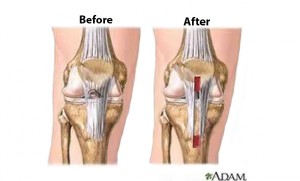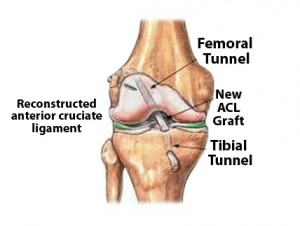Anterior Cruciate Ligament (ACL) Reconstruction with Allograft
Anterior Cruciate Ligament (ACL) Reconstruction with Allograft reconstruction is a surgical tissue graft replacement of the anterior cruciate ligament, located in the knee, to restore its function after Anterior Cruciate Ligament injury. The torn ligament is removed from the knee before the graft is inserted through a hole created by a single incision. The surgery is performed arthroscopically.
Anterior Cruciate Ligament (ACL) Repair with Allograft reconstruction is one of the most common procedures performed by orthopedic surgeons.
Preparation
You will usually have ACL reconstruction three to eight weeks after your injury. This allows any swelling to go down. Your surgeon may ask you to have physiotherapy during the weeks after your injury. This is to make sure you can move your knee as fully as possible before your operation.
ACL reconstruction can be done using either local or general anesthesia. A local anesthetic completely blocks pain from your knee area and you will stay awake during the operation. If you have a general anesthetic it means you will be asleep during your operation.
If you’re having a general anesthetic, it’s important to follow your anesthetist’s advice. You will usually be asked to not eat or drink for about six to twelve hours beforehand.
Your surgeon will complete a medical history and physical, order blood work, and other diagnostic tests. You may also be asked to give your consent for the procedure by signing a consent form.
Surgery
During arthroscopic ACL reconstruction, the surgeon makes several small incisions—usually two or three around the knee. Sterile saline (salt) solution is pumped into the knee through one incision to expand it and to wash blood from the area. This allows the doctor to see the knee structures more clearly.
The surgeon inserts an arthroscope into one of the other incisions. A camera at the end of the arthroscope transmits pictures from inside the knee to a TV monitor in the operating room.
Surgical instruments are inserted through other small incisions. The surgeon drills small holes into the upper and lower leg bones where these bones come close together at the knee joint. The holes form tunnels through which the graft will be anchored.
The surgeon will also make another incision in the knee and insert the graft (replacement tissue).

Recovery
Anterior Cruciate Ligament (ACL) Repair with Allograft reconstruction surgery is often done on an outpatient basis, which means that you do not spend a night in the hospital.
You will feel tired for several days. Your knee will be swollen, and you may have numbness around the incision on your knee. Your ankle and shin may be bruised or swollen. You can put ice on the area to reduce swelling. Most of this swelling will go away in a few days, and you should soon start seeing improvement in your knee.
To care for your incision while it heals, you need to keep it clean and dry and watch for signs of infection.
Physical rehabilitation after ACL surgery may take several months to a year. The length of time until you can return to normal activities or sports is different for every person. It may range from 4 to 6 months.
Risks
Anterior Cruciate Ligament (ACL) Repair with Allograft reconstruction surgery is generally safe. Complications that may arise from surgery or during rehabilitation (rehab) and recovery include:
- Problems related to the surgery itself. These are uncommon but may include:
- Numbness in the surgical scar area.
- Infection in the surgical incisions.
- Damage to structures, nerves, or blood vessels around and in the knee.
- Blood clots in the leg.
- The usual risks of anesthesia.
- Problems with the graft tendon (loosening, stretching, reinjury, or scar tissue). The screws that attach the graft to the leg bones may cause problems and require removal.
- Limited range of motion, usually at the extremes. For example, you may not be able to completely straighten or bend your leg as far as the other leg. This is uncommon, and sometimes another surgery or manipulation under anesthesia can help. Rehab attempts to restore a range of motion between zero degrees (straight) and 130 degrees (bent). It’s important to be able to get your knee straight so you can walk normally.
- Grating of the kneecap (crepitus) as it moves against the lower end of the thighbone (femur), which may develop in people who did not have it before surgery. This may be painful and may limit your athletic performance. In rare cases, the kneecap may be fractured while the graft is being taken during surgery or from a fall onto the knee soon after surgery.
- Pain, when kneeling, at the site where the tendon graft was taken from the patellar tendon or at the site on the lower leg bone (tibia) where a hamstring or patellar tendon graft is attached.
- Repeat injury to the graft (just like the original ligament). Repeat surgery is more complicated and less successful than the first surgery.

